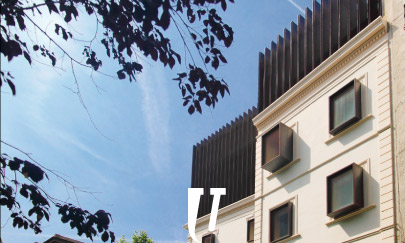Downloads

URSSA CORTEN. Generalities
Special characteristics, recommendations and precautions to Corten steel.
Introduction
The steels with atmospheric corrosion improved resistance are also called steels resistant to inclemency.
With that steels, the architects, engineers, sculptors, designers and decorators, get a material which color change constantly during the rusting process and because of the light effect and the atmospherically conditions. The superficial rust layer of this steel becomes more and more stable during the pass of the years, unlike the covering color steels which, because of the aggression from atmospheric agents, lose color and gradually, it decomposes. It natural reddish color becomes more integrated in the surroundings.
During the initial stage of the corrosion, it forms a layer of impermeable oxide very well-adhered. This layer consists in iron oxide enriched with the elements of the alloy which manufactured such as copper, chromium, nickel and phosphorus. This compact superficial oxide layer, which forms slower or most quickly, according to the atmosphere that involves it, prevent an additional dissemination of the oxygen in the base metal and it eliminates the internal corrosion.

In other words, it is not necessary to paint to protect from atmosphere conditions (rain, snow, wind, sun) the structures which are made with this steel. These steels are suitable to manufacture bins, electric and TV towers, mechanical buildings structures, warehouses, building cladding systems or Industrial plants, roofs of plants, bridges, fences of all kinds, sculptures, street furniture like street lamps, pergolas, etc.
ENVIROMENTAL INFLUENCE
The degree of exposure has great influence on the formation of the protective layer. If located in a place directly exposed to rain, sun and wind oxide layer is formed faster than when protected. In the latter case, the oxide tends to be rougher somewhat less dense and less uniform.
Frequent changes in humidity and drying are conducive to accelerating the process of weathering. Air pollution also has its efeco so in these steels moderate industrial environments, usually faster and protect acquire darker tones, while in rural environments failsafe process is slower and rust tones generally more clear.
In climates in acidic environments the protection process is slower, however, they can be used successfully.
Corten steel is not recommended in the following environments:
- Atmospheres containing industrial chemicals or corrosive vapors concentrates.
- Locations subject to saltwater spray or mist containing salt.
- Continuously immersed in water, buried in the ground or bridges contaminated with deicing salts leaking through the seals, expansion joints or open joints water.
- In direct contact with wooden decks.
- In structures exposed for long periods to moisture.
In these cases is not recommended to use these steels without protection because the oxide coating is not properly formed.
Protective coatings Corten Steel
In general, weather-resistant steels are used without protection or coating.
However, in areas where moisture can accumulate, elements submerged or buried, embedded or encased in concrete, soil or gravel, are advisable parts antioxidant primer app quality clean surface on the well.
Also in overlapping areas, if the water flows, by capillary action, it could be introduced into the joint and cause corrosion so also must be protected.
The primer can be the same type as those used in carbon steel, being applied to about 10 cm above-ground portion.
Protective coverings: If water passes through overlapping joints, because of the capillarity action, the water could be introduced by the joint and produce the corrosion. Therefore, the overlapping joint contact surface should be protected to avoid the entrance of moisture.
Our technical and sales staff may advise you the best solution.

